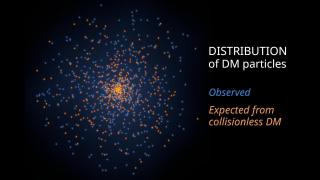We find a distinct stellar population in the counterrotating and kinematically decoupled core of the isolated massive elliptical galaxy NGC 1700. Coinciding with the edge of this core, we find a significant change in the slope of the gradient of various representative absorption line indices. Our age estimate for this core is markedly younger than the main body of the galaxy. We find lower values for the age, metallicity, and Mg/Fe abundance ratio in the center of this galaxy when we compare them with other isolated elliptical galaxies with similar velocity dispersion. We discuss the different possible scenarios that might have lead to the formation of this younger kinematically decoupled structure and conclude that, in light of our findings, the ingestion of a small stellar companion on a retrograde orbit is the most favored.
Advertised on
References
2011, ApJ, 732L, 33K
It may interest you
-
 The TESS (Transiting Exoplanet Survey Satellite) mission has discovered many exoplanet candidates that need to be confirmed and characterized from the ground. One of them orbits Ross 176, a K-type dwarf star, where we have identified a promising hot “water-world” candidate. Using spectroscopic observations with the CARMENES instrument, we confirmed the planetary nature of the signal detected by TESS and estimated the planet’s mass. To improve the analysis, we applied an advanced statistical method called Gaussian Process, which allowed us to separate the star’s own variability (quite strongAdvertised on
The TESS (Transiting Exoplanet Survey Satellite) mission has discovered many exoplanet candidates that need to be confirmed and characterized from the ground. One of them orbits Ross 176, a K-type dwarf star, where we have identified a promising hot “water-world” candidate. Using spectroscopic observations with the CARMENES instrument, we confirmed the planetary nature of the signal detected by TESS and estimated the planet’s mass. To improve the analysis, we applied an advanced statistical method called Gaussian Process, which allowed us to separate the star’s own variability (quite strongAdvertised on -
 The existence of dark matter is probably one of the fundamental mysteries of modern science and unraveling its nature has become one of the primary goals of modern Physics. Despite representing 85% of all matter in the Universe, we do not know what it is. In its simplest description, it is made up of particles that interact with each other and with ordinary matter only through gravity. However, this description does not correspond to any physical model. Finding out what dark matter is requires finding evidence of some kind of interaction of dark matter that goes beyond gravity. In our workAdvertised on
The existence of dark matter is probably one of the fundamental mysteries of modern science and unraveling its nature has become one of the primary goals of modern Physics. Despite representing 85% of all matter in the Universe, we do not know what it is. In its simplest description, it is made up of particles that interact with each other and with ordinary matter only through gravity. However, this description does not correspond to any physical model. Finding out what dark matter is requires finding evidence of some kind of interaction of dark matter that goes beyond gravity. In our workAdvertised on -
 Measuring galaxy sizes is essential for understanding how they were formed and evolved across time. However, traditional methods based on l ight concentration or isophotal densities often lack a clear physical meaning. A recent study from Trujillo+20 explores a more physically motivated definition: the radius R 1, where the stellar surface density falls to 1 solar masses per parsec square —roughly the threshold for gas to form stars in galaxies like the Milky Way. In this work, Arjona-Gálvez+25 uses over 1,000 galaxies from several state-of-the-art cosmological simulations (AURIGA, HESTIAAdvertised on
Measuring galaxy sizes is essential for understanding how they were formed and evolved across time. However, traditional methods based on l ight concentration or isophotal densities often lack a clear physical meaning. A recent study from Trujillo+20 explores a more physically motivated definition: the radius R 1, where the stellar surface density falls to 1 solar masses per parsec square —roughly the threshold for gas to form stars in galaxies like the Milky Way. In this work, Arjona-Gálvez+25 uses over 1,000 galaxies from several state-of-the-art cosmological simulations (AURIGA, HESTIAAdvertised on